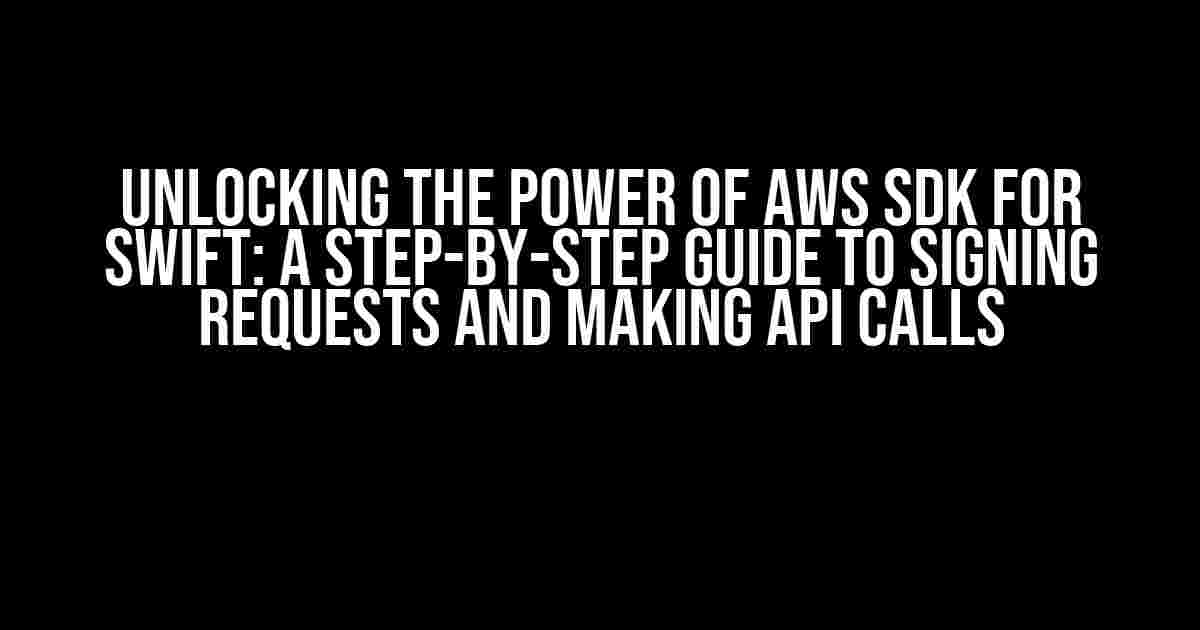Are you ready to take your Swift development skills to the next level by leveraging the capabilities of Amazon Web Services (AWS)? Look no further! In this comprehensive guide, we’ll explore the ins and outs of using the AWS SDK for Swift to sign requests and make API calls. By the end of this article, you’ll be well-equipped to integrate AWS services seamlessly into your Swift applications.
What is the AWS SDK for Swift?
The AWS SDK for Swift is a collection of libraries that provide a Swift-friendly interface to AWS services. It allows developers to interact with AWS resources and services, such as Amazon S3, Amazon DynamoDB, and AWS Lambda, directly from their Swift applications. With the SDK, you can focus on building scalable and efficient applications without worrying about the intricacies of AWS service integration.
Setting Up the AWS SDK for Swift
Before we dive into signing requests and making API calls, let’s get started with setting up the AWS SDK for Swift. Follow these steps to get started:
-
Install the AWS SDK for Swift using the following command:
swift package add AWSSDKSwift -
Import the AWS SDK in your Swift file:
import AWS SDKSwift -
Initialize the SDK with your AWS credentials:
let credentials = AWSCredentials(accessKey: "YOUR_ACCESS_KEY",
secretKey: "YOUR_SECRET_KEY",
region: "YOUR_REGION")
AWS.sdkInitialize(with: credentials)
Note: Replace “YOUR_ACCESS_KEY”, “YOUR_SECRET_KEY”, and “YOUR_REGION” with your actual AWS credentials and region.
Signing Requests with the AWS SDK for Swift
Signing requests is an essential step in interacting with AWS services. The AWS SDK for Swift provides a convenient way to sign requests using the `AWS SigV4` signing protocol. Here’s how you can sign requests:
let request = URLRequest(url: URL(string: "https://dynamodb.us-west-2.amazonaws.com/")!)
request.httpMethod = "POST"
request.httpBody = "YOUR_REQUEST_BODY".data(using: .utf8)
let signer = AWS4Signer(credentials: credentials,
region: "us-west-2",
service: "dynamodb")
let signedRequest = try! signer.sign(request: request)
let signature = signedRequest.httpHeaders["X-Amz-Signature"]
print("Signed request: \(signedRequest)")
print("Signature: \(signature ?? "")")
In the code snippet above, we create a `URLRequest` object and set the HTTP method and body. We then create an instance of `AWS4Signer`, passing in our AWS credentials, region, and service name. Finally, we sign the request using the `sign(request:)` method and print the signed request and signature.
Making API Calls with the AWS SDK for Swift
Now that we’ve signed our request, let’s make an API call to a DynamoDB table. We’ll use the `AWS DynamoDB` client to interact with our table:
let dynamoDB = AWSDynamoDB.defaultClient()
let tableName = "YOUR_TABLE_NAME"
let getRequest = AWSDynamoDBGetItemInput(
tableName: tableName,
key: ["id": "YOUR_ITEM_ID"]
)
dynamoDB.getItem(getRequest) { (result, error) in
if let error = error {
print("Error: \(error)")
return
}
if let item = result?.item {
print("Item: \(item)")
}
}
In this example, we create an instance of `AWSDynamoDB` and define a `GetItem` request. We then use the `getItem(_:)` method to fetch an item from our DynamoDB table. In the completion handler, we print the item or any errors that might occur.
Additional Tips and Tricks
Here are some additional tips and tricks to keep in mind when using the AWS SDK for Swift:
-
Enable logging to diagnose issues:
AWS.sdkLoggingEnabled = true -
Use asynchronous calls to improve performance:
dynamoDB.getItem(getRequest) { (result, error) in ... } -
Create a custom `AWSCredentialsProvider` to manage credentials:
class CustomCredentialsProvider: AWSCredentialsProvider {
func getCredentials() async throws -> AWSCredentials {
// Return your custom credentials
}
}
-
Use `AWS SDK Swift` plugins to integrate with popular frameworks:
swift package add AWS SDKSwift-AWSLambda
Conclusion
In this comprehensive guide, we’ve explored the ins and outs of using the AWS SDK for Swift to sign requests and make API calls. By following these instructions and tips, you’ll be well-equipped to integrate AWS services seamlessly into your Swift applications. Remember to enable logging, use asynchronous calls, and create custom credentials providers to improve performance and security. Happy coding!
| AWS Service | Description | Swift SDK |
|---|---|---|
| Amazon S3 | Object storage | AWSS3 |
| Amazon DynamoDB | NoSQL database | AWSDynamoDB |
| AWS Lambda | Serverless computing | AWSLambda |
Don’t forget to explore the official AWS SDK for Swift documentation and GitHub repository for more information and resources.
Frequently Asked Question
AWS SDK for Swift is a powerful tool that enables developers to interact with AWS services programmatically. But, have you ever wondered how to use it to sign requests and make API calls? Let’s dive into the most frequently asked questions about using AWS SDK for Swift to sign requests and make API calls!
Q1: What is the AWS SDK for Swift and how does it sign requests?
The AWS SDK for Swift is a collection of libraries that enables developers to interact with AWS services programmatically. The SDK uses the AWS credentials provided to sign requests to AWS services on behalf of the user. This signature is generated using the AWS access key ID, secret access key, and security token (optional). The SDK takes care of signing the requests, so you don’t need to worry about the nuances of AWS signature version 4!
Q2: How do I set up AWS credentials for the SDK?
To set up AWS credentials for the SDK, you need to create an AWS account and obtain your access key ID and secret access key. Then, you can configure the SDK by providing the credentials through environment variables, a shared credentials file, or a custom credentials provider. The SDK will use these credentials to sign requests to AWS services.
Q3: What is the difference between synchronous and asynchronous API calls in the AWS SDK for Swift?
The AWS SDK for Swift provides both synchronous and asynchronous API calls. Synchronous API calls block the execution of your code until the response is received, whereas asynchronous API calls return immediately, allowing your code to continue executing. Choose the approach that best fits your use case, but keep in mind that asynchronous API calls are generally more efficient and scalable!
Q4: Can I use the AWS SDK for Swift with AWS services that require custom signing?
Yes, the AWS SDK for Swift supports custom signing for AWS services that require it. You can provide a custom signing handler to the SDK, which will be used to sign requests to those services. This flexibility allows you to integrate with a wide range of AWS services and customize the signing process to meet your specific needs!
Q5: How do I handle errors and exceptions when making API calls with the AWS SDK for Swift?
The AWS SDK for Swift provides robust error handling and exception mechanisms to help you handle errors and exceptions when making API calls. You can use try-catch blocks to catch and handle errors, and leverage the SDK’s built-in error types and error messages to diagnose and resolve issues. Don’t let errors hold you back – use the SDK’s error handling features to write more robust and resilient code!



